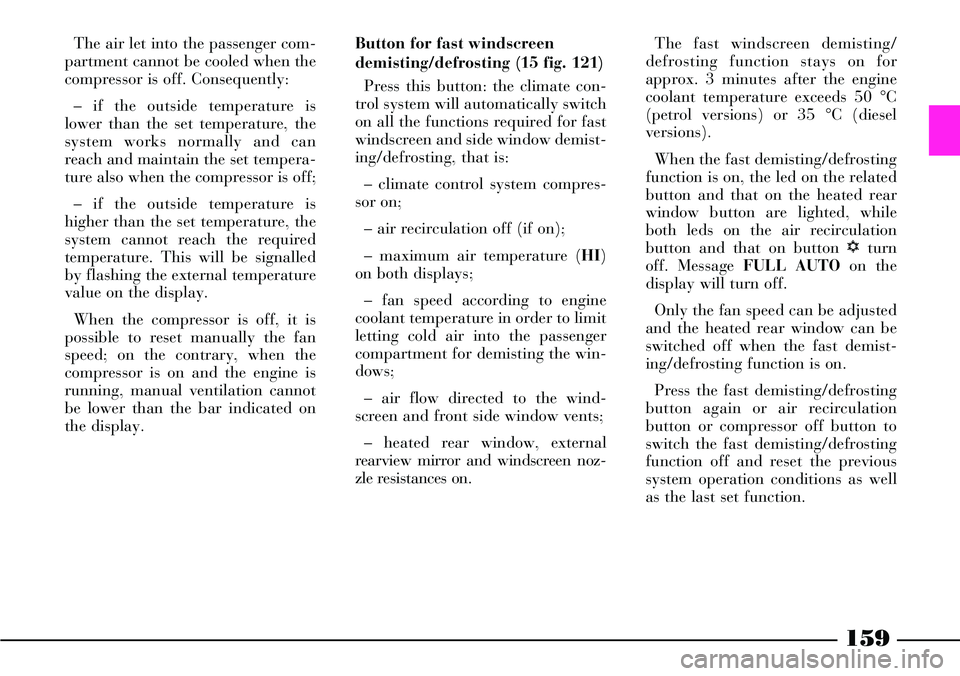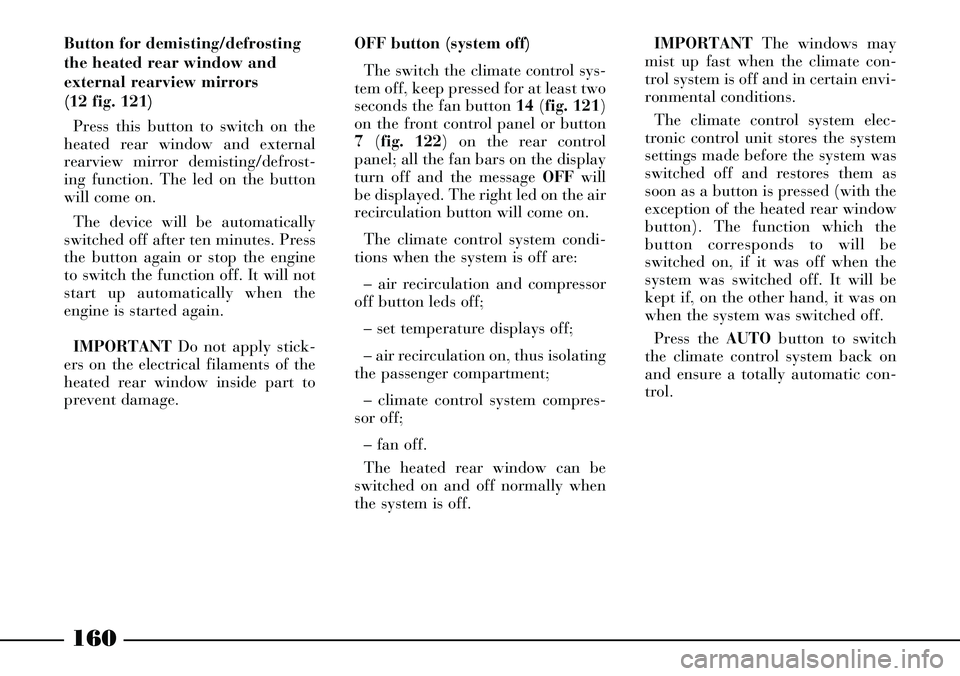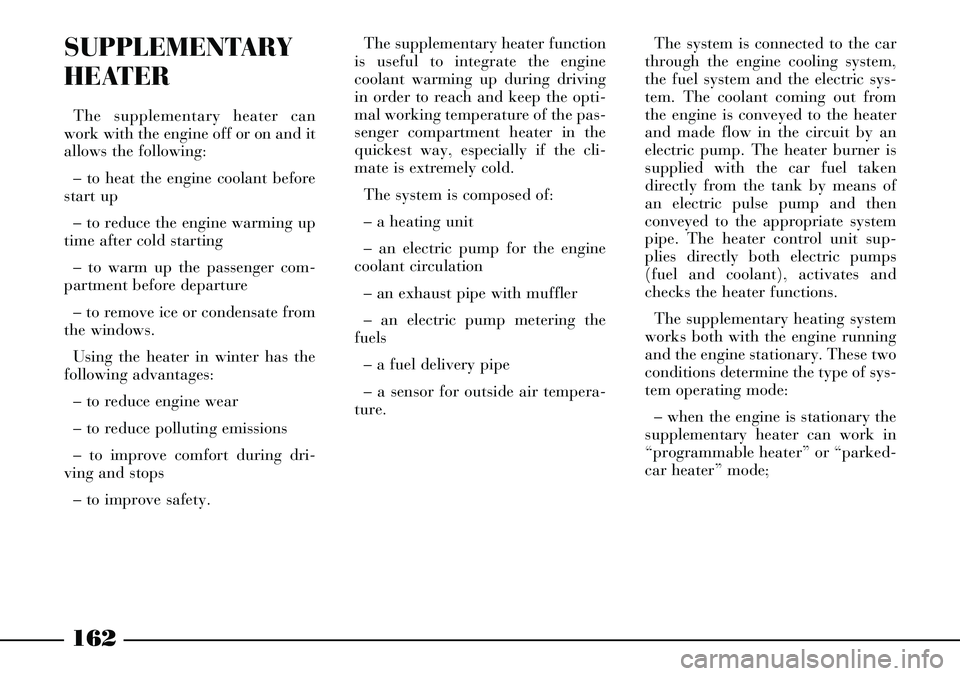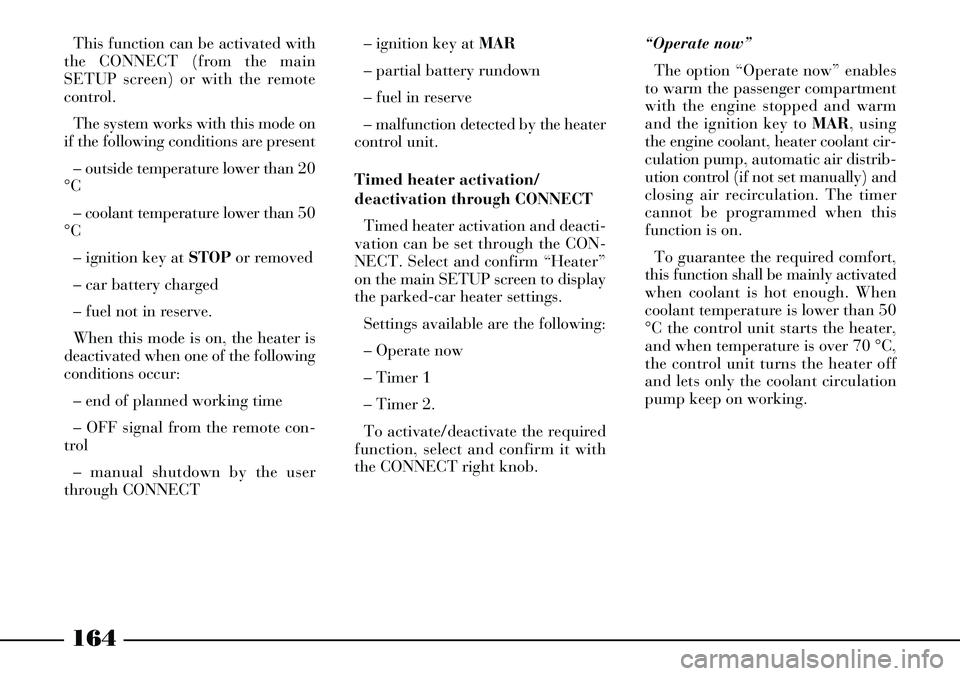air condition Lancia Thesis 2006 Owner handbook (in English)
[x] Cancel search | Manufacturer: LANCIA, Model Year: 2006, Model line: Thesis, Model: Lancia Thesis 2006Pages: 386, PDF Size: 8.69 MB
Page 154 of 386

153
To switch this function off, turn
the temperature knob to the left and
set the required temperature.
– LOfunction (maximum cooling):
it is activated by turning the temper-
ature knob to the left beyond the
minimum value (16 °C). It can be
independently switched on from dri-
ver’s side or from (front/back) pas-
senger’s side or from both sides (also
by selecting the MONOfunction).
This function can be switched on to
speed up cooling the passenger com-
partment by exploiting the system
potential to the maximum. This
function cuts out the heater and
switches the air recirculation and the
climate control compressor on. The
air distribution and the fan speed
are selected according to the envi-
ronmental conditions. All the manu-
ally settings can be adjusted when
the function is on. To switch this
function off, turn the temperature
knob to the right and set the
required temperature.Buttons for adjusting front air
distribution (10, 18 fig. 121)
Press these buttons to manually
select one of the seven possible air
distribution patterns in the front
passenger compartment (right and
left side):
AAir flow to windscreen and front
side window vents for defrosting/
demisting the windows.
FDAir flow to central and side
dashboard vents and the rear vents.
IMPORTANTOn versions equipped
with solar cell operated sunroof
(where provided), to check opera-
tion at first speed of climate control
system fan when the car is parked,
disengage air vents and set air distri-
bution from central dashboard vents
only before leaving the car.
SAir flow to the front and rear
footwells. The air distribution pat-
tern, due to the natural tendency of
heat to move upwards, allows to
heat the passenger compartment up
as fast as possible. Furthermore, it
offers a prompt feeling of warmth to
the coolest parts of the body.Air flow shared between
footwell vents (warmer air)
and central and side dashboard
vents and the rear vents (cooler air).
This air distribution pattern is par-
ticularly useful in middle seasons
(spring and autumn) when it is
sunny.
Air flow shared between the
footwell vents and the windscreen
and front side window
defrosting/demisting vents. This air
distribution pattern ensures a good
heating of the passenger compart-
ment and prevents possible misting
up.
Air flow distribution between
central and side dashboard
vents, rear vents and windscreen
and front side window vents.
Air flow distribution
between all passenger com-
partment vents.
Air distribution setting is displayed
when leds relevant to the selected
button are lit, which will be turned
off in case of fully automatic opera-
tion (FULL AUTO). F
SD
A
S
FA
D
FA
SD
Page 156 of 386

155
Buttons for adjusting fan speed
(13, 14 fig. 121 – 7, 8 fig. 122)
Press respectively front control
buttons 13or 14 (fig. 121) and back
control buttons 8or 7 (fig. 122) to
increase or decrease the fan speed so
to adjust the amount of air let into
the passenger compartment while
keeping the required temperature
constant.
The fan speed is indicated by the
bars which light up on the front dis-
play 5 (fig. 121) and rear display 3
(fig. 122), when the back control
panel is active. Repeatedly press
button or keep pressed 13 (fig. 121)
or 8(fig. 122) to switch the fan on
at top speed (all bars on).
Repeatedly press or keep pressed
button 14(fig. 121) or 7(fig. 122)
to switch the fan on at minimum
speed (one bar on).When the fan minimum speed is
set up (one bar on), by keeping
pressed for at least two seconds but-
ton 14(fig. 121) or 7(fig. 122), the
climate control system is deactivated
and all the fan bars on the display
turn off; OFFmessage is displayed.
The fan speed can be adjusted
manually through both the front
control panel and the rear control
panel, but it is the same one for the
whole passenger compartment.
IMPORTANTPress the AUTO
button to restore air distribution
control after a manual setting.AUTO buttons
(automatic operation)
(1, 9 fig. 121 - 5 fig. 122)
Press the AUTObutton on the dri-
ver side and/or front/back-seat pas-
senger side: the system will automat-
ically control the air amount and
distribution pattern in the related
passenger compartment areas and
will cancel all the previously made
settings. This condition is marked by
the message FULL AUTOon the
system front and rear display,
besides the leds on the air distribu-
tion buttons turning off.
If one of the functions automatical-
ly controlled by the system (air recir-
culation, air distribution, fan speed
or air conditioner compressor deacti-
vation) is manually adjusted, the
message FULLon the display turns
off to indicate that the system is no
longer controlling the functions inde-
pendently (apart from temperature
control that is always automatic).
Page 158 of 386

The climate control system can be
deactivated also by the rear control
panel, when operating: press repeat-
edly or keep pressed button 7 (fig.
122) until all the fan bars on the dis-
play turn off and message OFFis
displayed.
To exclude the rear control panel,
press again button REAR; the but-
ton led turns off and the front-seat
passenger’s controls are operating
again.
Air recirculation on/off button
(3 fig. 121)
The air recirculation function is
controlled according to three strate-
gies:
– automatic operation (button left
led on);
– forced ventilation on (recircula-
tion always on), the right led on the
button will come on;– forced deactivation off (recircula-
tion always off, air taken from the
outside), both leds on the button will
go off.
The three conditions are obtained
by pressing the air recirculation but-
ton 3in sequence.
When the air recirculation function
is automatically controlled by the
system, the left led on the air recir-
culation button is turned on, while
the right led is on or off according to
the actual recirculation conditions
(on or off).
During automatic operation, the
recirculation function is automati-
cally switched on when the pollution
sensor detects the presence of pollut-
ed air, e.g. in cities, queues, tunnels
and during windscreen wiper opera-
tion (due to the characteristic smell
of alcohol). In addition, if the compressor is on
and the outside temperature is over
5 °C, to prevent air polluted by
exhaust gases getting inside the pas-
senger compartment during stops,
the system stops air recirculation
when the car speed is lower than 6
km/h. When the car speed returns
over 12 km/h, the system restores
the previous conditions.
After using the air recirculation
function for a long time (over 15
consecutive minutes), the system
automatically stops it for safety rea-
sons, thus letting air be changed.
When air recirculation manual
control is set (button left led off),
message FULLon the display is off.
157
Page 159 of 386

158
IMPORTANTAir at a temperature
lower than that of the outside air
cannot be let in to the passenger
compartment when the compressor
is off. Furthermore, in particular
environmental conditions, the win-
dows could mist up fast because the
air is no longer dehumidified.
The setting will be stored when the
engine is stopped. Either press √
button again or press the AUTObut-
ton to reset automatic control of the
compressor (in the latter case, the
manual settings will be cancelled).
The led on the √button will go out. IMPORTANTThe air recircula-
tion function will allow, according to
the system operation (i.e. heating or
cooling) to reach the required condi-
tions faster. We recommend not
turning on this function on rainy
and/or cold days as this will consid-
erably increase window misting,
especially if the climate control sys-
tem is off.
In particular climate
conditions (e.g. low out-
side temperature or high
humidity) and with the inside air
recirculation automatic control
on, windows could start misting
up. In this case, press the air
recirculation button and set it to
forced open position (both button
leds off), and increase air flow to
the windscreen, if required.Climate control system
compressor off button (7 fig. 121)
Press the √button, when the but-
ton led is on, to switch the air condi-
tioner compressor off. The led will
go off. By pressing again the button
when the led is off, the system auto-
matic control of the compressor acti-
vation is restored; this situation is
indicated by button led lighting up.
When the air conditioner compres-
sor is off, if the system is no longer
able to keep the requested tempera-
ture, the message FULL AUTOon
the display turns off and the system
deactivates air recirculation to pre-
vent window misting up. Instead, if
the system is still able to maintain
the requested temperature, the mes-
sage FULLon the display will stay
on.
Page 160 of 386

159
The air let into the passenger com-
partment cannot be cooled when the
compressor is off. Consequently:
– if the outside temperature is
lower than the set temperature, the
system works normally and can
reach and maintain the set tempera-
ture also when the compressor is off;
– if the outside temperature is
higher than the set temperature, the
system cannot reach the required
temperature. This will be signalled
by flashing the external temperature
value on the display.
When the compressor is off, it is
possible to reset manually the fan
speed; on the contrary, when the
compressor is on and the engine is
running, manual ventilation cannot
be lower than the bar indicated on
the display. Button for fast windscreen
demisting/defrosting (15 fig. 121)
Press this button: the climate con-
trol system will automatically switch
on all the functions required for fast
windscreen and side window demist-
ing/defrosting, that is:
– climate control system compres-
sor on;
– air recirculation off (if on);
– maximum air temperature (HI)
on both displays;
– fan speed according to engine
coolant temperature in order to limit
letting cold air into the passenger
compartment for demisting the win-
dows;
– air flow directed to the wind-
screen and front side window vents;
– heated rear window, external
rearview mirror and windscreen noz-
zle resistances on.The fast windscreen demisting/
defrosting function stays on for
approx. 3 minutes after the engine
coolant temperature exceeds 50 °C
(petrol versions) or 35 °C (diesel
versions).
When the fast demisting/defrosting
function is on, the led on the related
button and that on the heated rear
window button are lighted, while
both leds on the air recirculation
button and that on button √turn
off. Message FULL AUTOon the
display will turn off.
Only the fan speed can be adjusted
and the heated rear window can be
switched off when the fast demist-
ing/defrosting function is on.
Press the fast demisting/defrosting
button again or air recirculation
button or compressor off button to
switch the fast demisting/defrosting
function off and reset the previous
system operation conditions as well
as the last set function.
Page 161 of 386

160
Button for demisting/defrosting
the heated rear window and
external rearview mirrors
(12 fig. 121)
Press this button to switch on the
heated rear window and external
rearview mirror demisting/defrost-
ing function. The led on the button
will come on.
The device will be automatically
switched off after ten minutes. Press
the button again or stop the engine
to switch the function off. It will not
start up automatically when the
engine is started again.
IMPORTANTDo not apply stick-
ers on the electrical filaments of the
heated rear window inside part to
prevent damage.OFF button (system off)
The switch the climate control sys-
tem off, keep pressed for at least two
seconds the fan button 14 (fig. 121)
on the front control panel or button
7 (fig. 122) on the rear control
panel; all the fan bars on the display
turn off and the message OFFwill
be displayed. The right led on the air
recirculation button will come on.
The climate control system condi-
tions when the system is off are:
– air recirculation and compressor
off button leds off;
– set temperature displays off;
– air recirculation on, thus isolating
the passenger compartment;
– climate control system compres-
sor off;
– fan off.
The heated rear window can be
switched on and off normally when
the system is off.IMPORTANTThe windows may
mist up fast when the climate con-
trol system is off and in certain envi-
ronmental conditions.
The climate control system elec-
tronic control unit stores the system
settings made before the system was
switched off and restores them as
soon as a button is pressed (with the
exception of the heated rear window
button). The function which the
button corresponds to will be
switched on, if it was off when the
system was switched off. It will be
kept if, on the other hand, it was on
when the system was switched off.
Press the AUTObutton to switch
the climate control system back on
and ensure a totally automatic con-
trol.
Page 162 of 386

161
ACTIVE CARBON
DUST/POLLEN FILTER
The filter has the specific capacity
of combining a mechanical air
cleaning action and an electrostatic
effect so that the air let into the pas-
senger compartment is purified from
particles such as dust, pollen, etc.
In addition to this function, the fil-
ter efficaciously reduces the concen-
tration of pollutants thanks to a
layer of active carbon inside the fil-
ter.
The filtering action is carried out
on the air let in from outside (recir-
culation off).
Have the filter checked at least
once a year at a Lancia
Dealership, ideally at the begin-
ning of the summer.The efficacy of the cli-
mate control system may
be considerably reduced
if the filter is not replaced.Fan actuation is automatic and air
distribution corresponds to the latest
setting made before switching the
car off.
This function is useful especially on
summer days since it greatly reduces
the temperature inside the passenger
compartment as well as the duration
of the cooling cycle after car start-
up, thus avoiding the accumulation
of warm air in the air conditioning
unit lines.
IMPORTANTBest operation of
the fan when the car is parked is
obtained by closing completely the
windows and sunroof. Furthermore,
to check operation at first speed of
the fan, disengage air vents and set
air distribution from central dash-
board vents only before leaving the
car.You should have the filter checked
and if required replaced more fre-
quently if the car is mainly used in
polluted or dusty areas.
VENTILATION DURING A STOP
In versions with sunroof, the roof
top features 21 photovoltaic cells
supplying a maximum power of 24
W to supply the climate control sys-
tem fan when the car is parked with
the roof closed or horizontally pivot-
ing.
Page 163 of 386

162
SUPPLEMENTARY
HEATER
The supplementary heater can
work with the engine off or on and it
allows the following:
– to heat the engine coolant before
start up
– to reduce the engine warming up
time after cold starting
– to warm up the passenger com-
partment before departure
– to remove ice or condensate from
the windows.
Using the heater in winter has the
following advantages:
– to reduce engine wear
– to reduce polluting emissions
– to improve comfort during dri-
ving and stops
– to improve safety.The supplementary heater function
is useful to integrate the engine
coolant warming up during driving
in order to reach and keep the opti-
mal working temperature of the pas-
senger compartment heater in the
quickest way, especially if the cli-
mate is extremely cold.
The system is composed of:
– a heating unit
– an electric pump for the engine
coolant circulation
– an exhaust pipe with muffler
– an electric pump metering the
fuels
– a fuel delivery pipe
– a sensor for outside air tempera-
ture.The system is connected to the car
through the engine cooling system,
the fuel system and the electric sys-
tem. The coolant coming out from
the engine is conveyed to the heater
and made flow in the circuit by an
electric pump. The heater burner is
supplied with the car fuel taken
directly from the tank by means of
an electric pulse pump and then
conveyed to the appropriate system
pipe. The heater control unit sup-
plies directly both electric pumps
(fuel and coolant), activates and
checks the heater functions.
The supplementary heating system
works both with the engine running
and the engine stationary. These two
conditions determine the type of sys-
tem operating mode:
– when the engine is stationary the
supplementary heater can work in
“programmable heater” or “parked-
car heater” mode;
Page 165 of 386

164
This function can be activated with
the CONNECT (from the main
SETUP screen) or with the remote
control.
The system works with this mode on
if the following conditions are present
– outside temperature lower than 20
°C
– coolant temperature lower than 50
°C
– ignition key at STOPor removed
– car battery charged
– fuel not in reserve.
When this mode is on, the heater is
deactivated when one of the following
conditions occur:
– end of planned working time
– OFF signal from the remote con-
trol
– manual shutdown by the user
through CONNECT– ignition key at MAR
– partial battery rundown
– fuel in reserve
– malfunction detected by the heater
control unit.
Timed heater activation/
deactivation through CONNECT
Timed heater activation and deacti-
vation can be set through the CON-
NECT. Select and confirm “Heater”
on the main SETUP screen to display
the parked-car heater settings.
Settings available are the following:
– Operate now
– Timer 1
– Timer 2.
To activate/deactivate the required
function, select and confirm it with
the CONNECT right knob.“Operate now”
The option “Operate now” enables
to warm the passenger compartment
with the engine stopped and warm
and the ignition key to MAR, using
the engine coolant, heater coolant cir-
culation pump, automatic air distrib-
ution control (if not set manually) and
closing air recirculation. The timer
cannot be programmed when this
function is on.
To guarantee the required comfort,
this function shall be mainly activated
when coolant is hot enough. When
coolant temperature is lower than 50
°C the control unit starts the heater,
and when temperature is over 70 °C,
the control unit turns the heater off
and lets only the coolant circulation
pump keep on working.
Page 175 of 386

174
Lift cover Aset at the driver's left
and press button Bto reset the fuel
cut-off switch.
Resetting the circuit breaker
Before resetting the cir-
cuit breaker, carefully
check for any fuel leaks or
damages to the car electric devices
(e.g.: headlights).Circuit breaker is located on the left
side of the boot, inside a box directly
set and connected to the battery pos-
itive terminal.
To reach the circuit breaker:
1) Open the tailgate.
2) Loosen knob A(fig. 130) and re-
move the battery cover B.
3) Press tabs A(fig. 131) and re-
move cover B.
4) Press button A(fig. 132) to reset
the circuit breaker.Initialising the control units of
the door locks, air conditioner
and ESP system
After resetting the circuit breaker, to
restore correct door locking, air con-
ditioning and ESP system, perform
the following operations:
1) Close the doors and the tailgate,
fit the key into the lock of one of the
front doors and perform a door cen-
tralised opening/closing cycle.
2) Start the engine and turn on the
compressor of the conditioner, setting
a lower temperature value than that
of the environment and check
whether the led on the disconnection
push button of the conditioner com-
pressor òis lit.
3) Turn the steering wheel one
fourth turn at least (the car can be at
standstill but the engine shall be run-
ning) and start running the car for a
few metres in a straight line until the
ESP warning light
áis off.
fig. 131
L0A0031b
fig. 132
L0A0347b